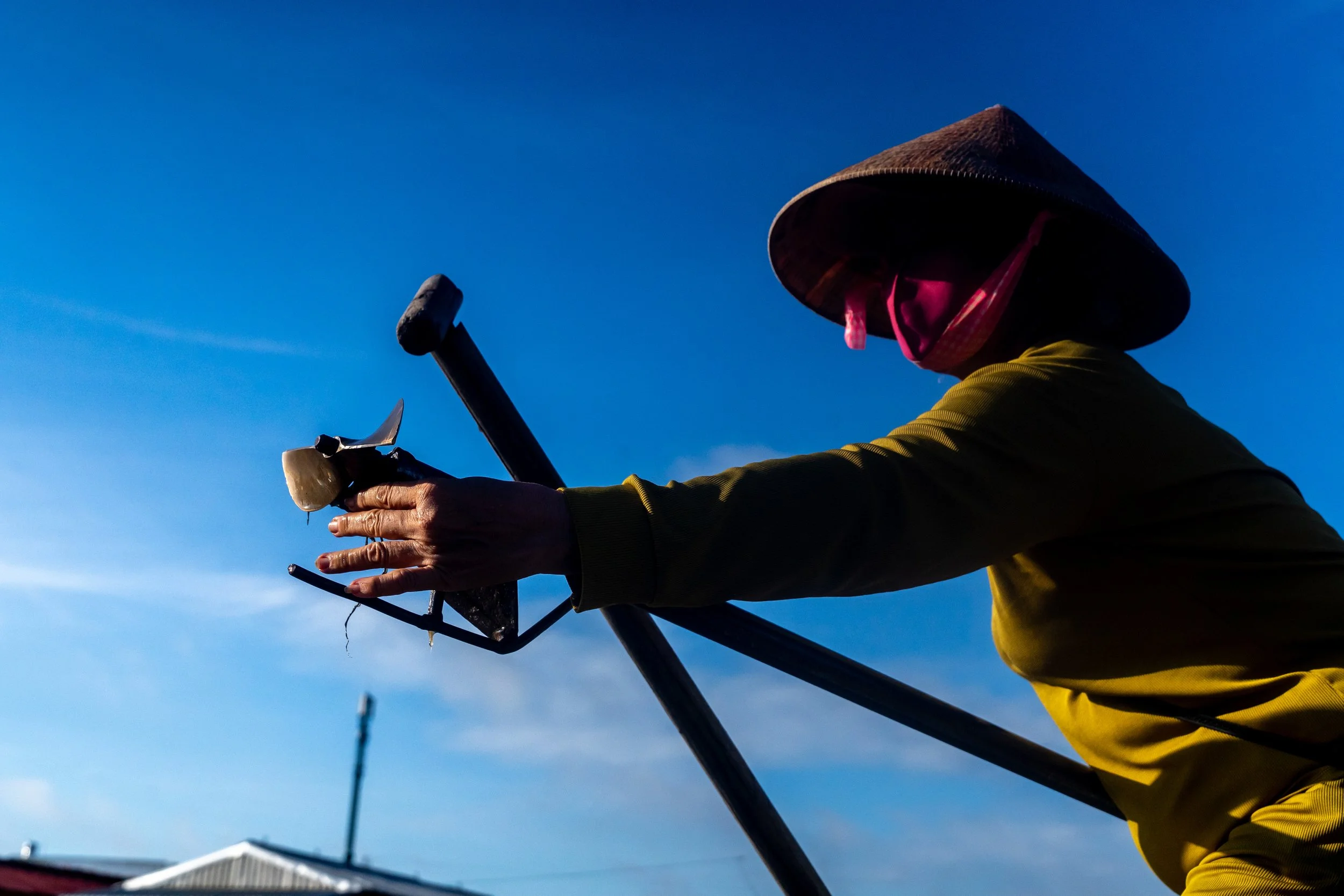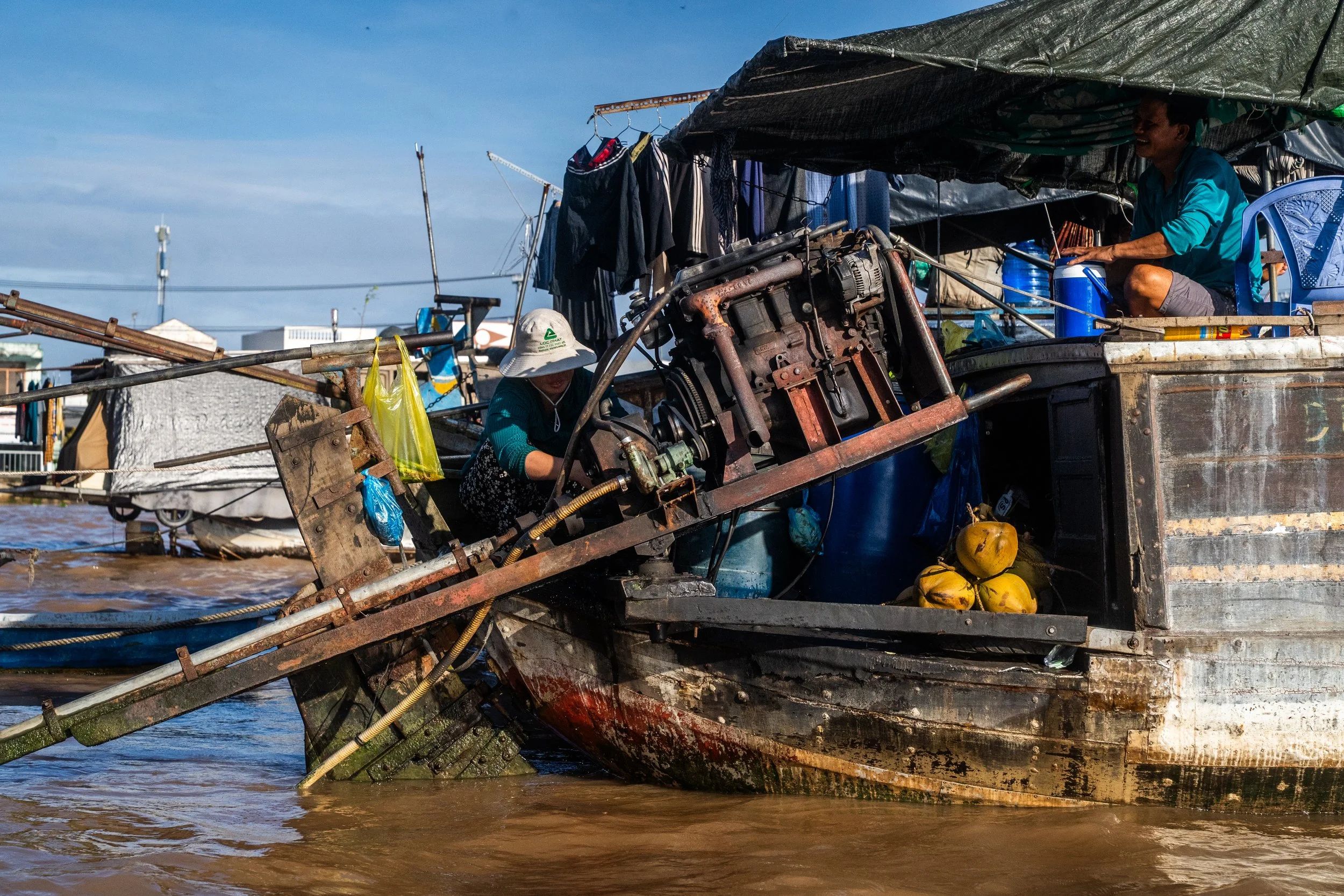TradItion and Tide: Life on The Mekong.
At 5 am, life on the Mekong roars; it is a vibrant, rumbling dance of tradition and rhythm. Merchants shout over the markets’ hum, and traders nearly sink their small vessels with fresh produce.
The lives connected to the Mekong seemed to mirror it. The many years of floods, loss, life and harvest, etched deep into their sun-kissed skin like the river’s meandering tributaries.
I am just a witness to their world. Come drift with me through the Mekong's currents, camera in hand, to capture a story that may not last forever.
A Boat Trader removes plastic wrapped around the propeller.
The Mekong is one of the world’s great rivers. Rising in the Tibetan Plateau, it winds its way through Laos, Cambodia and Vietnam, carrying life across thousands of kilometres. Its deep brown colour comes from the sediment gathered along its vast journey across the Asian continent, nourishing the millions who depend on it. Yet, like all ecosystems, the Mekong faces mounting pressures from modernisation, pollution, agricultural runoff, pesticides and damming that threaten its future.
A Local Boat Trader pushes his boat away from the docks.
Plastics trapped in Water Hyacinth, near floating houses on the Mekong.
The pace of life in Can Tho is dictated by the river’s current. Its tides swell with force, often spilling over the banks and flooding nearby streets and homes. Locals have grown accustomed to these rhythms, wading knee-deep through waterlogged alleys while market vendors rush to higher ground.
Can Tho streets flooding due to river rising.
Can Tho Riverside Market at Dawn.
Squished between motorbikes pushing through the narrow market streets, my leg pressed against the rattling warmth of an exhaust, I watched the rhythm of the market caper around me.
Catfish, eel, crab and turtles, along with every kind of seafood, exchanged hands for crumpled notes of dong, as heavy smoke from cigarettes and charcoal stoves curled in the air. Thin sheets of ice splintered across metal pans to keep the catch fresh while the temperature rose steadily and the humidity seemed to turn into a living thing.
A Can Tho Local Stands Next to the Mekong at Dawn.
I felt a strong hand grip my bicep. I turned and found the eyes of a woman fixed on mine. She spoke the word “boat”, intoned like a chant.
I had no choice but to follow as she dragged me forward like the Mekong’s current itself. She gave me a fair price. We did not barter. I respected her tenacity, and she let me capture her image before being directed to the boat guide.
Her days of mastering the river's currents had long passed, with her eyes starting to gloss and their colour fading. She walked with the physical stiffness that comes from hard work.
She flagged down her partner, who captained the small vessel, splitting the boat fare between them. She ushered me down a set of slippery steps to where the small, angular boat sat low in the river.
A Cai Rang River Trader negotiates produce price.
The small motor spluttered and spat water as our props dropped into the fast-moving current. Distant yells skipped over the river like a stone, hands pointing as money passed between outstretched fingertips of traders selling produce.
Boats clanked and groaned as they pressed into each other, cushioned by old tyres tied to their sides. People hopped on and off different boats, inspecting the sellers’ produce curiously, as if at a regular supermarket. I was in awe of the way they navigated the river.
Mekong Traders Load fresh pumkins on their boat.
Commercialisation:
While these traditions are timeless, they are being altered by forces beyond the river’s edge.
The landscape is changing for the local traders, with the primary mode of transport for goods now shifting to trucks, which can load and deliver directly to and from local farmers.
New highways and bridges are cutting deep into the river economy. The completion of the Co Chien Bridge reduced the travel distance between Trà Vinh and Ho Chi Minh City by around 60 kilometres, making truck transport far quicker and more efficient than traditional river routes (World Bank, 2016).
As a result, floating markets such as Cái Răng are experiencing a decline in the number of trading boats each year, with local vendors citing improved roads and embankments as the primary reason for the decline (Earth Journalism Network, 2024).
Boats carrying commercial signs cruise under a bridge that stetches the river.
Environmental Factors:
Recent surveys have revealed rising levels of microplastics, heavy metals and pesticides contaminating the Mekong. In one study, researchers screened 64 pesticides across 276 samples and found 56 pesticides in surface water and 43 in soils (Ngin et al., 2024).
Plastic pollution is also a growing concern, with baseline surveys in the Mekong Delta recording an average of around 54 microplastic particles per cubic metre of surface water (Kieu-Le et al., 2023).
Compared to big city rivers such as the Saigon, where microplastic loads can exceed 200,000 particles/m³, the Mekong’s ~54 particles/m³ still reflects moderate to high contamination; by contrast, cleaner systems like upland tributaries of the Mekong in Laos often record fewer than 5 particles/m³.
While there are glimmers of hope, with international organisations helping with environmental policies, risk management and infrastructure, the efforts are dwarfed by the Mekong's grandeur.
With researchers warning that funding cuts threaten critical conservation work, and environmental programs like USAID's $2.9 million three-year initiative to protect coastal habitats in Vietnam's Mekong Delta operating on budgets measured in millions rather than billions, the financial commitment pales against the enormity of protecting a river system that feeds Southeast Asia.
I sat on the splintering seat of the boat, looking across the river’s edge, imagining how many vessels used to drift against the murky current. My Guide waved his weathered hand, pointing toward the empty horizon, gesturing to where boats used to trade. It was a stark reminder of the rapid shift happening and the immediate effect on this way of life.
The floating market trade is not just shrinking in physical presence; it's eroding generationally. In a study by Mekong Eye, researchers found that in Cái Răng, for instance, only about 200 active traders operate, down from 500 in 2016.
In smaller markets like Ngã Năm and Ngã Bảy, the same study revealed fewer than ten boats remain active. The decline has left hundreds of river traders displaced and seeking alternative work.
According to research from Mekong Eye, the older generation reminisces about a time when Ngã Bảy alone had 800 vendor boats each day. Meanwhile, younger people are increasingly seeking work off the river, preferring more stable and less physically demanding jobs.
As one trader explained in an interview with Al Jazeera, 'My daughter doesn't want to work here … she prefers to work for a company and invest in stocks'.
A Can Tho Trader smiles for his portrait.
Our boat slid through a tangle of water hyacinth, engine finally quiet. Across the dock, the woman in red who had dragged me into this world waved once before disappearing into the market's chaos, swallowed by the same currents of commerce that have sustained her family for generations.
I showed the boat driver the photos on my camera - him wrestling plastic from the propeller, traders balancing impossible loads, floating homes weathering another tide. He laughed and pointed at the image of tangled plastic, shaking his head. Some problems, his gesture seemed to say, we just learn to live with.
Stepping from weathered wood to concrete, I felt the weight of solid ground beneath my feet - stable, predictable, modern. Behind me, the Mekong rolled on, carrying its ancient rhythms toward an uncertain future. I looked back and gave my guide a final wave and wondered how much longer he would be able to bear the river’s strangled pulse.
If you have made it this far, thank you. I truly appreciate it.
I hope you enjoyed this piece, and if you would like to support my work, please consider pressing the donate button, sharing it with your friends or leaving a comment. I would love to hear what you think.
Thank you,
Michael






















